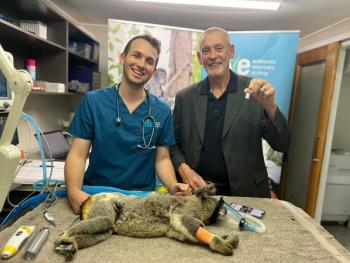
- Vetted October 2019
- Volume 114
- Issue 10
Herpesvirus and the feline eye
When one of your veterinary patients develops this ubiquitous veterinary infectious disease, try these diagnostic, treatment and prevention strategies.
“Herpes, the gift that keeps on giving,” is how Mary B. Glaze, DVM, MS, DACVO, an ophthalmologist at Gulf Coast Animal Eye Clinic in Houston, Texas, described feline herpesvirus (FHV-1) during her session at the 2018 Atlantic Coast Veterinary Conference, held in October in Atlantic City, New Jersey. Epidemiologists think that upwards of 95% of cats throughout the world have been exposed to the virus, Dr. Glaze said, and probably 80% of those that have been infected are now carriers.
As one of the most common causes of ophthalmic disease in cats, FHV-1 “can be a chronic source of frustration” for practitioners and owners alike, said Dr. Glaze. During her interactive, case-based lecture, she shared the recommended tests and most effective treatment options for this ubiquitous infectious disease.
Perceive the pathogenesis
FHV-1 is spread through close contact with an infected cat; respiratory, oral and ocular secretions are infective. “Cats invariably acquire the infection as neonates,” Dr. Glaze noted. The queen, who is already stressed by all of the activity around her, is likely reactivating her own herpesvirus. As the kitten's maternal antibodies begin to wane and the queen's virus is continuing to shed, she shares that with her kittens.” The kittens will either have signs of infection before their eyelids open (ophthalmia neonatorum) or they will have respiratory disease (rhinotracheitis) with bilateral conjunctivitis.
See the signs
Although both kittens and adult cats can be exposed to FHV-1, they tend to show very different clinical signs. Kittens usually present with bilateral, painful conjunctivitis with first a serous, then mucopurulent, exudate. In very young kittens, Dr. Glaze said, this conjunctivitis may be accompanied by a keratitis so severe that “adjacent raw epithelial surfaces adhere to one another, producing symblepharon.”
Clinical signs in adult cats are more likely to represent viral reactivation from latency rather than primary infection. Recurrences tend to be unilateral rather than bilateral, affecting the same eye repeatedly while the other eye remains clinically normal. Recurrent conjunctivitis is the most common feature of viral recrudescence, although discomfort, conjunctival hyperemia chemosis, and ocular discharge are usually less severe than with the initial infection.
Discern the diagnosis
Ophthalmologists don't really like to admit it, Dr. Glaze joked, but we really only have three diagnostic tests at our disposal: tonometry (to check for secondary glaucoma or uveitis), the Schirmer tear test and fluorescein staining. All are used in potential cases of FHV-1.
Once the medical history, which is sometimes incomplete, is obtained, diagnosis continues with a physical exam. Often, examination of a particularly painful eye can be facilitated by administering a topical anesthetic such as proparacaine. This also gives the patient temporary relief. However, a Schirmer tear test should not be performed subsequently, as the topical anesthetic can alter results of the tear test. Fortunately, Dr. Glaze noted, dry eye is not very common in cats with FHV-1 conjunctivitis, so the topical anesthetic has more value than risk.
Physical exam findings are often as expected (e.g. chemosis, hyperemia, ocular discharge), but considerable variation is possible. Dr. Glaze noted, “Cats can have some pretty profound ocular disease and not necessarily look as red as we're used to seeing in dogs.”
She discussed two diagnostic paradigms when dealing with these cases. First, when a cat presents with conjunctivitis, it should be presumed infectious until proven otherwise. “This is why we advise against using symptomatic corticosteroid therapy in feline conjunctivitis,” she said. Second, feline corneal ulceration should be considered a consequence of herpesvirus infection until proven otherwise.
Unlike other species we deal with, cats have primary conjunctival and corneal pathogens, so they don't require any other predisposing factor or precipitating event to get conjunctivitis or ulceration. FHV-1 is frequently implicated, but Chlamydia felis may also be involved in feline conjunctivitis. However, chlamydia is not ulcerative. Adnexal disease, entropion, foreign bodies, and other conditions are also possible. When trying to distinguish physical exam findings, Dr. Glaze noted that “herpesvirus is a superficial corneal disease. If there is deeper corneal pathology, other factors, such as secondary bacterial infection, are at play.”
FHV-1 is typically diagnosed based on three things: clinical judgment, lack of response to routine antibacterial therapy and improvement with antiviral therapy. Dr. Glaze pointed out that there is no diagnostically reliable test for FHV-1; not even the polymerase chain reaction test can distinguish between natural infection and vaccination. Some clinicians use response to antiviral therapy to support a diagnosis of FHV-1 conjunctivitis. However, Dr. Glaze cautioned, “if you're using response to antiviral therapy as a yardstick, then you need to choose an agent that is likely to be effective, and you need an exceptionally compliant client, as topical antiviral therapy requires frequent application.” In most cases, she said, if you suspect FHV-1 in one of your feline patients, the next step is to begin treatment.
Take in the treatment
As a general rule, Dr. Glaze said to avoid corticosteroids until an infectious cause is ruled out. And cats with secondary bacterial involvement may improve with antibacterial therapy. But what about cats with unresponsive or recurrent disease? Most cats and kittens with herpes viral conjunctivitis don't end up on antiviral drugs, which may leave practitioners wondering whether antiviral therapy is a safe, effective and necessary option for the treatment of FHV-1.
Although antiviral agents cannot prevent or eradicate latent viral FHV-1 infection, Dr. Glaze advised, they should still be considered when ocular signs are severe, persistent or recurrent or when corneal ulceration is present. Dr. Glaze prefers systemic antiviral therapy to topical therapy, because orally administered famciclovir controls the disease well. However, she acknowledged that oral medication can be difficult to administer in some cats. She added, “Just remember that antiviral agents tend to be more toxic than antibacterial agents, even when applied topically. Use caution and your judgment.”
Dr. Glaze recommended a few topical and systemic antivirals that have been used to manage FHV-1 successfully in feline patients.
She said to steer clear of acyclovir and valacyclovir, which are either ineffective or potentially lethal in cats. In contrast, she has had good results with topical idoxuridine, which has to be compounded, and commented that this medication is well-tolerated by most cats and financially feasible for many clients. Topical cidofovir has the advantage of twice-daily dosing compared with five times daily for idoxuridine, but it is considerably more expensive. “Selection of an antiviral against FHV-1 is not necessarily a straightforward decision,” Dr. Glaze warned. “An agent seemingly effective in one cat may have limited benefit in another.”
Ancillary therapies include lysine (although its effectiveness has recently been brought into question, especially among shelter cats) and interferons. Dr. Glaze commented that L-lysine given in boluses twice daily helps some cats, but interferon does not seem to diminish clinical signs or viral shedding effectively. If prolonged treatment with an antiviral and/or an antibiotic fails to improve the patient's clinical signs, Dr. Glaze recommended stopping treatment for a few days and prescribing hyaluronan-based artificial tears to provide soothing for the patient during the washout period.
Treatment choices vary widely among ophthalmologists, she said, and antiviral regimens should be tailored to the individual. Topical irritation is common, she noted, especially with trifluridine, and is often misinterpreted as treatment failure when conjunctival inflammation worsens. In addition, the stage of infection, the severity of clinical signs, owner finances, and compliance should all be considered.
Articles in this issue
about 6 years ago
Three ways to celebrate your veterinary techniciansabout 6 years ago
Why is your veterinary clinic giving up pharma sales?about 6 years ago
Having a vaccine talk? Keep these 8 tips in mindover 6 years ago
Post-veterinary school, my sleep is permanently screwedover 6 years ago
What veterinarians can do when pet owners snarlabout 7 years ago
Print: 'You're one heck of a tech!'over 7 years ago
Journal Scan: In veterinary surgery, check thrice, cut onceNewsletter
From exam room tips to practice management insights, get trusted veterinary news delivered straight to your inbox—subscribe to dvm360.






